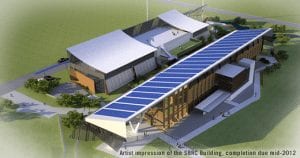Bluescope Steel is hoping to capture a good share of the building integrated photovoltaic market (BIPV), which is expected to increase 10-fold across the globe in coming years and become a key part of new construction, and even building retrofits.
Bluescope today was awarded a $2.3 million grant from the Federal Government under its Emerging Renewables program to accelerate the development of a new roofing profile that combines Australian steel roofing and inverter systems with second-generation thin-film solar technologies.
It follows the awarding of a grant earlier this year from the Australian Solar Institute which will help it combine these systems with a unique thermal element (BIPVT), by erecting the solar panels in an elevated area and capturing and using the warm air underneath.
The company says it expects its product – combining roofing profile designs and incorporating solar panels – will be suitable for “mass deployment” across residential, commercial and industrial rooftops, and without the need for subsidies. It believes it will offer cost advantages over conventional rooftop PV systems by reducing installation and energy costs and reducing peak demands on the grid.
“The prototype will be easily scaled up to the operational stage ensuring future BIPV systems can be cost-effective without government subsidies,” Resources and Energy Minister Martin Ferguson said in a statement. “This project will help make Australia a world leader in BIPV development.”
In a recent interview with RenewEconomy, Bluescope’s head of coating product development, Dr Troy Coyle, said that the company – as a big seller of roofing materials – recognizes that innovation in designs, and incorporating energy production was a key part of the future market. “That is where the roofing industry is heading,” she said.
The global BIPV market was estimated to be worth just 1,200MW in 2010, but it expected to jump 10-fold to 11,300MW by 2015. “The market motivator is energy reduction, and the motivator for integration into rooftop design is a reduction of material costs and in building heating costs,” Coyle said. “That way we can have it all done in one.”
The $477,000 ASI grant is focused on some of software required for such products, while the Emerging Renewables grant – which will be matched by Bluescope in a near $5 million, two year program – will be research and development.
Coyle said that the thermal component was critically important in bringing added benefits to rooftop installations on new buildings. “The additional functionality offsets some of the operational costs of the building,” she said.
And it could help in retrofits. A new roof deck above the existing roof surface can incorporate solar cells, and air then flows in the duct created under the new roof surface. This air flow will not only help cool the solar cells during warm weather, improving generation efficiency, but it will also help to heat and cool the building. Warm air generated in winter is used for heating, and as heat is radiated from the cells on summer nights, cool air is then supplied to the building, increasing overall energy efficiency.
Bluescope sees this technology being applicable in the residential, commercial and industrial markets.
Although the costs of BIPV are difficult to estimate, at least in its early commercial deployment, the International Energy Agency last year said in a report that the cost of BIPV would effectively disappear, because it would become integrated into overall building costs, in the same way as double-glazed windows. “PV roof costs may never meet a floor price,” it said in its Solar Perspectives report. “We see a growing role for BIPV to satisfy building codes that call for zero-energy buildings. By spreading costs across both the building energy system (or part of it anyway) and the building fabric, it becomes possible to create a new economics for PV that – at the very least – will increase the size of its market.”
Note: Ferguson has certainly been busy these past few days dishing out grants from a funding program he ostensibly no longer controls – the Emerging Renewables Fund now under the auspices of the independent and newly formed Australian Renewable Energy Agency.
No matter, the clean energy industry is champing at the bit for the long promised funds to be distributed, and the two grants to the wave energy groups Oceanlinx and BioPower Systems announced on Tuesday were welcome, along with today’s grant for Bluescope.
One fascinating part of the press release, however, came at the end, where Ferguson acknowledged forecasts by AEMO that rooftop solar is likely to account for 5GW by 2020 and 12GW by 2031. No excuses, then, for these forecasts, and for sensible cost assumptions, to be included in the updated Energy White Paper.







